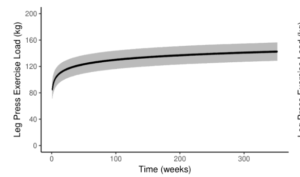What does just 20 minutes of working out (in your street clothes) get you over 7 years?

What does just 20 minutes of working out (in your street clothes) get you over 7 years?
Dave and I absorb a lot of content on health. And it’s often confusing.
By writing our blog for 11 year now (yes you read that correctly…..we are now officially old), we have observed a lot of ‘trends’ in healthcare research.
A current trend is clearly what I like to call “A race to the bottom”.
Put simply: “what is the minimum amount I can do to get the maximum benefit?”
I think this trend is congruent with our uber optimized society. I blame the ‘7 minute abs’ videos for starting all of this. Only to be topped by ‘5 minute abs’. (For the young folks out there this is reference to a scene in a classic comedy film There’s Something About Mary……I told you we are old!)
You see the same ‘race to the bottom’ trend in fitness research. It has been shown you get most of the health benefits (not performance benefits) associated with distance running by running just 5 minutes at a time. As further proof, one of our favourite researchers (Martin Gibala from McMaster University) literally wrote a book called “The One-Minute Workout”!
It is abundantly clear that when it comes to their health people want the maximum benefit…..while doing as little as possible.
Now here I go adding more fuel to the fire…..kind of.
How does this race to the bottom relate to strength training?
While quite a bit of research has shown positive correlation with strength training and big strength gains in the short term, surprisingly little has been done looking at minimal training effects long term.
In general strength declines in adulthood at roughly 1% per year. What most people do not realize is that this trend is not linear. Starting around 35 or 40 you slowly, but gradually, lose strength and then when you hit 60 there is a much more rapid decline.
Lots of studies show phenomenal strength gains in people lifting weights as little as once weekly over the course of 1-2 years. Typical is 20-100% gains over that time. But that’s where most studies stop……around the 2 year mark.
What happens after that?
This is important for obvious reasons to performance athletes. Do they just continue to get stronger forever?
But even more important is from a public health perspective. If we gradually lose strength in adulthood, and we know that lack of strength is an indicator of morbidity and mortality (grip strength is now recognized as a valid predictor of death), then if we can continually build strength by training just once a week is the fountain of youth before our very eyes?
A brand new article has been released in pre-print that explores this very question. The study was remarkable for its size and breadth of data.
There is a multinational fitness franchise that began in the Netherlands called Fit20 International. What is unique about this franchise is that members only lift weights once a week for a maximum of 20 minutes, performing the same 6-7 exercises each session…..in their street clothes.
Their tagline is “personal health training in 20 minutes per week…..no hassle with changing/showering.” Now THAT’S minimal effort.
To ensure standardization, each facility has no mirrors, no music, and participants use the same 6 machines in the same order. You work either one on one or two on one with a trainer who uploads your strength data during each session in real time on a tablet with information stored in the cloud.
This standardization made the Fit20 facility prime for researchers.
This current study looked at 14,690 people with average age 47 over a 7 year period.
At Fit20 participants only perform 4-6 repetitions of each exercise with each rep lasting 20 seconds total (10 seconds concentric, 10 seconds eccentric). After one set, they rest 20 seconds and move on to the next exercise. Each session lasts under 20 minutes total.
So what did the study find?
All exercises showed a similar pattern of strength growth (see below graph). As time progresses, the magnitude of strength change diminishes. About 30-50% of the gains occur in the first year, then 6 years later gains were only 50-60% increased from baseline. So you get large increases in the first year, then minimal thereafter (the slope levels off dramatically as seen below).

The slopes were the same for sex, age, and how many sessions you performed.
Here are the conclusions I draw from this study:
- You can obtain incredible strength gains by working out just once a week for under 20 minutes in your street clothes. Honestly mind blowing results with minimal effort.
- I would argue the ‘strength program’ they used was a bit suboptimal. However, similar findings (meaning big gains for a year or two, then very small gains thereafter) were found in another study I found in professional female powerlifters followed for 10 years. So it seems not to matter what type of strength program you are following, it just matters that you do something.
- Maybe the ‘odd program’ is a good thing. This was about as easy as it gets – 6 exercise sets total in under 20 minutes – meaning EVERYONE can do it.
- The most important conclusion to me is the potential public health finding (see below)
If we know that strength gains decline at roughly 1% per year, then this entire sample of adults (with an age range of 35 to 59) should have lost roughly 6-7% of their overall strength over the period of this study. This is massive……but normal.
Instead, this group sustained (small) strength gains at 7 years that were on average 50-60% compared to baseline when they began the workout program.
So instead of a 6% loss in strength (which is literally predictive of death), they instead gained 50-60% over the same period.
All that without changing clothes or showering!
